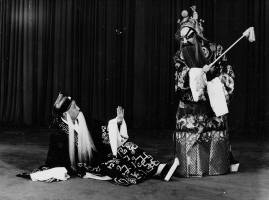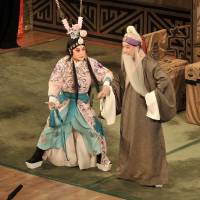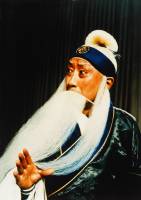The Orphan of Zhao (Zhaoshi guer)
Genre: jingju
Produced by Beijing Jingju Company/ Beijing Jingju Theatre, premiered in 1959
Performers: Zhu Qiang, Liu Zheng, Wei Jijun, Li Yangming
About the genre:
Jingju is not a local theatre in Beijing. Actually it was a highly developed urban theatre that appeared in the capital in the early 19th century. It was based on the pre-existent theatrical genres of kun, bangzi, jingqiang (alteration of the older yiyangqiang), huidiao, handiao and others. Most of first generation of jingju actors were from kun, hui and han theatrical genres. They selected and utilized the styles with which they were familiar and boldly innovated the repertoire and performing conventions of these pre-existent forms.
One greatest innovation was the language that jingju was to use. At that time, different troupes from different areas often presented their local genres with very different dialects on the same stage, and that caused great problems for audiences in Beijing. Thus the first challenge for jingju was to create its own artificial language, which would be understood easily by every member of the audience, ranging from locals to those who had come to the capital for business or for refuge, from peddlers to merchants, the gentry class, the literati and even the Manchu court. The creation of heightened speech, or yunbai (literally meaning rhymed speech), and colloquial speech, or jingbai (mainly using the Beijing local dialect) marked the completion of the new genre. The rhymed speech is normally used by high-class characters and scholars, while the colloquial speech by working class and comic roles.
Surpassing its “regional ancestors”, jingju, a newly created genre in the early 19th century of mixed blood, was not only stronger than any of the pre-existent genres, but also looked and sounded familiar in many different areas. This explains why it spread quickly and widely in China since the early 20th century.
Jingju is a complex theatrical amalgamation. Every aspect of the genre — singing, speaking, dance-acting, combat, costuming and make-up — has to follow certain modes, patterns or rules. Central to the system is the categorization of role types (see Xiqu); each role type is codified by specific requirements for voice, singing, gesture, body movements, dance, make-up and costume. There are four role types: sheng (male), dan (female), jing (painted face) and chou (comic role); each has its own sub-categories. Traditional repertoires are all created around specific role types.
Jingju’s aria is mainly composed in two model systems: erhuang from the hui theatre and xipi from the handiao. Different modes are organized according to metrical types. Every metered metrical type provides a pattern of an accented beat and unaccented beat(s). The lyrical structure of jingju aria is in couplets, and therefore the musical construction consists of opening and closing lines. Each line of the libretto contains either seven or ten syllables. Jingju also uses “melodic models”, taken from pre-existent genres such as kun, hui and others.
The traditional repertoire, according to the performing techniques, are generally divided into two types: civilian (focusing on singing) and military (focusing on acrobatics and martial arts).
Scenario:
The Orphan of Zhao is a play based on historical records. The orphan was born circa 583 BC during the Spring-Autumn Period – a time when imperial power was being eroded by the growth of numerous aristocratic-family-states. Appalled by the chaos and bloodshed, philosophers such as Confucius (551-479 BC) acted as advisors to rulers on how to control their states and people.
Historical records present contradictory accounts of the story. Most versions of different theatrical genres and films we see now are based on the extant full-length tragedy Wrongs Avenged by the Orphan of Zhao by Ji Junxiang, written in the Yuan dynasty when China was ruled by the Mongols (1279-1368 AD).
The basic story is as follows: schemed by the evil courtier Tu’an Gu, the Zhao clan were all killed except for the Princess who was the Jin Ruler’s sister and was pregnant. After the baby was born, he was smuggled out by a doctor called Cheng Ying. Having realized that the baby boy had escaped, Tu’an Gu gave the order to kill all the newly born boys in the country. Finally, Cheng Ying decided to give up his own child for the Zhao orphan. Meanwhile Cheng Ying and his friend, a retired minister Gongsun Chujiu made a plan. Cheng would report to Tu’an about Gongsun who had the Zhao orphan in his house. Actually the real Zhao orphan was hidden in the deep mountain while Cheng’s own baby son was with Gongsun. Tu’an killed both Gongsun and the child. In order to reward Cheng Ying as a loyal reporter, Tu’an took both Cheng Ying and his son (but actually Zhao’s offspring) to his house and Tu’an made himself the foster father of the boy.16 years later, Cheng Ying revealed the true story to the young man. The orphan of Zhao took the revenge on Tu’an, for his parents, grandparents, his clan and for Cheng Ying. In order to rescue this orphan many people died.
This is an archetypal Chinese story of loyalty, honesty, sacrifice, friendship, evil, revenge, bravery, and justice.
This clip is taken from the jingju production, which was premiered in 1959 by Ma Lianliang, one of the Four Sheng Masters, and the current actor Zhu Qiang (as Cheng Ying) is one of his third-generation disciples. Through acting Cheng Ying, Zhu studied Master Ma’s singing, speaking and acting skills thoroughly from his teacher Zhang Xuejin who had learned the role from Ma Lianliang himself. This process exemplified how the tradition of jingju, as well as that of other older genres, was carried forward generation after generation. Meanwhile, each generation adds more to the repertoire and in this way, the tradition has been innovated constantly.
Traditionally jingju productions perform highlights of scenes taken from the Yuan play, and it was Ma Lianliang who made the first full-length version of the play on the modern stage. The 1959 jingju production was a beautiful artistic piece; Ma’s unique skills of voice and movements created an exquisite character of Cheng Ying, yet, at the same time, it was also a product of the ideology of the time. The Jin ruler was described as lustful, cruel and incompetent; the spirit of fighting against evil was further stressed. The role of the maid to the orphan’s mother was given prominence as she represented the poor.
The clip is a trailer of the production that the Research Association of Ma Lianliang Performing Art made for the Leeds international symposium Performing China on the Global Stage, held in March 2013.
Images and the video are courtesy of Research Association of Ma Lianliang Performing Art.
《赵氏孤儿》
剧种:京剧
演出单位:北京京剧团/北京京剧院
原创:马连良
演员:朱强(马派第三代传人,为张学津的学生)、刘铮、魏积军、李阳鸣
剧种简介:
京剧并不是北京地区的地方戏。
京剧实际上是19世纪早期出现在在首都北京一种已经相当高度发展的城市戏剧,它的形成得益于已臻成熟的昆、梆子、京腔(是早年弋阳腔到达北方以后的变种)、徽调、汉调以及其他古老的剧种。京剧的第一代演员全都来自昆、徽、汉等声腔的演员,他们勇敢地、有选择地使用了他们各自所熟悉的剧种中的剧目、表演以及歌唱方法,以此创造出了京剧。
京剧的一大创新就是为自己创造出一种既可以供演员使用、又可以使观众听得懂的语言。根据史料记载,在当时非常繁华的京城来自不同地区的不同剧团往往在同一个舞台上演出各地不同的剧种,并使用不同的方言。这给当时北京的观众带来极大的不便。于是,第一代京剧演员必须为京剧发明出一种艺术性的语言,这种语言需要让观众中的每一员都可以听得懂,包括北京当地人、来到京城来避难或者作生意的人、商贩乃至商贾、士大夫阶层、文人乃至清朝宫廷成员。学者认为京剧在使用统一的韵白与京白之后,京剧基本上完成了作为一个新出现的剧种的创造过程。京剧韵白以“中州韵”为读音、咬字与归韵的标准,但是又有湖广音的影响,因此在其出现之始,很容易为北京来自各地的观众所接受,同时,节奏感与音乐性都很强。韵白为受过教育的、有身份的人物所使用,京白则以北京方言为标准,身份卑微者或者丑行使用为多。
19世纪上半叶逐渐形成的京剧以其“混血”的特点超越了在它之前的地方戏,“混血”使其不仅强壮,而且也让很多地方的观众听起来很“耳熟”。这就解释了为什么京剧在20世纪二十、三十年代迅速向全中国发展。
京剧是一个相当复杂的集大成的戏剧形式,其唱、做、念、打以及服装、化妆和道具都必须遵守一定的程式。 “程式”的中心部位是行当,每一个行当都有发声、歌唱、身段、形体、舞蹈、化妆和服装的一定之规。生、旦、净、丑为其基本行当,又各有细密的分工。 骨子老戏环绕行当而创造、形成的。
京剧的音乐基本属于板腔体,以徽调的二黄和汉调的西皮为主。 两者皆有不同的板式,板(强拍击板)眼(次强拍或弱拍)清楚、分明,唱词为上下句组成,唱词往往是七字或者十字句。京剧也使用一些来自昆腔、徽腔和其他剧种的曲牌。
骨子老戏有文戏和武戏之分。
剧情简介:
《赵氏孤儿》是一个春秋时代的故事。据史书记载,孤儿出生于公元前583年左右。当时受到“分封制”诸侯日益强大势力的侵蚀,周王权日益衰微,诸侯争霸称雄,战争与血腥屠杀连年不断。同时,诸子百家学说开始出现,并试图就如何管理国家和人民等等给予统治者以哲学性的思考。
史书有着互相矛盾的关于赵氏孤儿的记载。我们现在所看到的各种戏剧形式和电影版本基本上来自于元代纪君祥的《冤报冤赵氏孤儿》。
大致故事如下:奸臣屠岸贾设计将与自己不和的赵氏家族满门抄斩,唯一幸免的是已有身孕的、赵朔的妻子庄姬,她是晋王室的公主。男婴出生以后,就被一位叫作程婴的医生想办法带出了宫苑。当屠岸贾听说婴儿已经逃遁,便下令杀死举国上下所有在这段时期内出生的男婴。几经考量,程婴决定献出自己的亲生儿子以保全赵家唯一的骨血。与此同时,程婴和老友、已经告老还家的公孙杵臼安排了救孤的计划。程婴前往屠岸贾处报告公孙杵臼藏匿了赵氏的孤儿,而实际上,真正赵家的孤儿被藏在深山之中,而公孙那里的婴儿恰恰是程婴自己的孩子。屠岸贾杀死了公孙杵臼和婴儿,为报答程婴举报之功,他把程婴及其儿子(是真正的赵氏孤儿)接回自己家里,好生款待,并把男孩作为自己的养子来呵护养育。孤儿长大成人以后,程婴将孤儿的身世告诉了他本人。为给自己的父母、祖父母、赵氏家族以及为程婴报仇,孤儿杀死了屠岸贾。为了拯救孤儿,诸多英雄献出自己的生命。
《赵氏孤儿》是关于忠义、诚信、牺牲、友情、奸佞、报仇、勇猛和正义的中国原型。
本片断来自京剧《赵氏孤儿》,是四大须生马连良于1959年首演的作品,目前剧中扮演程婴的演员朱强是马派第三代传人。通过扮演程婴,朱强向老师张学津(他曾经向马连良本人学习过这出戏)深入地学习了马派的唱、念与做的技巧。这一过程展示了京剧(或者说所有古老的剧种),如何将其表演传统一代又一代地传下去。同时,每一代演员也都会给剧目或者人物加以自己的创新,正是这样一个“传”与“承”无限循环的过程,中国戏曲的传统得以保留、发扬和光大。
京剧传统上只演出《搜孤救孤》,是马连良首次在现代舞台上搬演了《赵氏孤儿》的这部完整的大戏。1959年的演出艺术感染力极强,马派的唱功与身段刻画出了一名出类拔萃、令人难忘的程婴。同时,我们也可以看到这是当时意识形态下的产物。晋灵公好色、残酷、无能;全剧向邪恶作斗争的精神得到空前的发扬。卜凤,这个公主身边的丫环的戏份也加强很多,她代表着下层人物的善良与明智。
本片断是马连良艺术研究会在2013年为国际研究互联网项目“舞台中国”召开国际会议“寰球演出中国”时专门制作的有关该剧演出的短片。
诚挚感谢马连良艺术研究会提供图片与录像。


